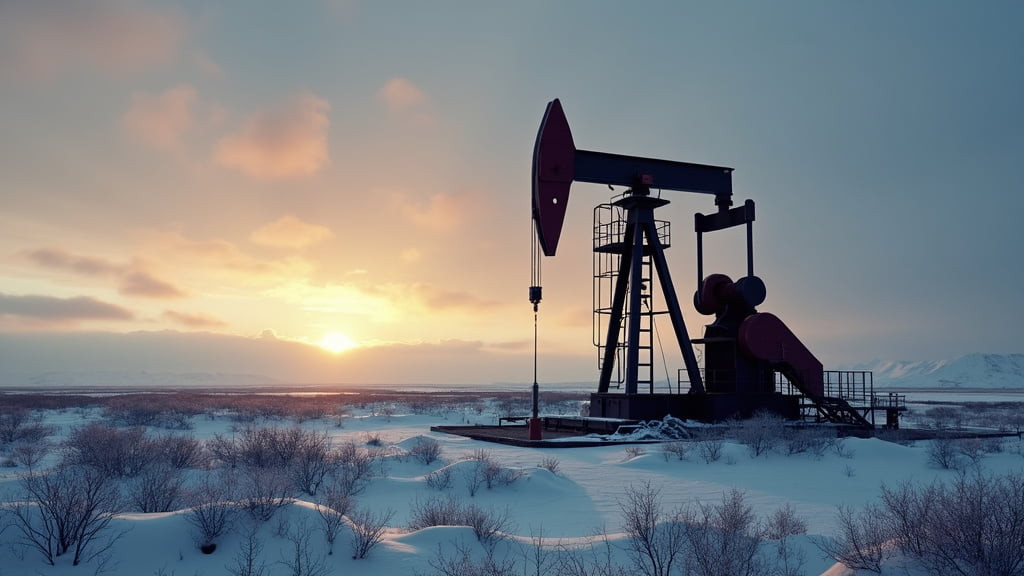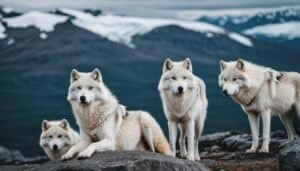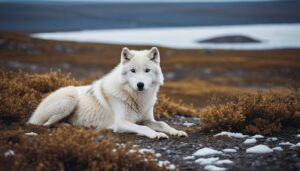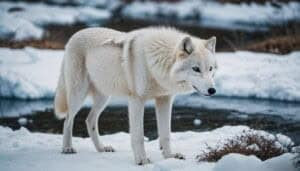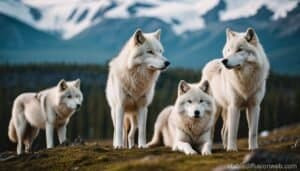Introduction
The Arctic wolf, an iconic predator of the frigid North, faces numerous challenges due to human activities. From climate change and industrial development to habitat fragmentation and changes in prey availability, these activities have profound impacts on their survival
This article delves into how various human actions affect the habitat of Arctic wolves, the consequences for their populations, and the efforts in place to mitigate these impacts
By understanding these influences, we can better appreciate the delicate balance of the Arctic ecosystem and the importance of preserving it for future generations
Human Activities Affecting Arctic Wolf Habitats
Human activities have increasingly encroached upon the Arctic, significantly impacting the habitats of Arctic wolves
This section explores the primary human-induced changes affecting these habitats, focusing on climate change, oil drilling, industrial development, and habitat fragmentation
Climate Change and Arctic Wolf Habitats
Climate change is one of the most pressing issues affecting Arctic ecosystems. The Arctic region is warming at twice the rate of the global average, leading to significant changes in the environment that Arctic wolves depend on:
Melting Ice and Permafrost
Arctic wolves rely on stable ice and permafrost for hunting and denning. As temperatures rise, ice melts earlier in the season and refreezes later, reducing the time wolves can access areas they traditionally hunt
Permafrost thawing also destabilizes the ground, making it difficult for wolves to create dens to raise their young. According to a study by the National Snow and Ice Data Center (2022), the Arctic has lost about 95% of its oldest and thickest ice, significantly impacting the habitat structure that wolves rely on
Changing Vegetation and Prey Availability
Climate change also affects vegetation patterns in the Arctic. As temperatures rise, shrubs and other vegetation spread into tundra areas, altering the habitat and availability of prey species like hares and lemmings
This shift can force Arctic wolves to travel longer distances to find food, increasing energy expenditure and reducing survival rates, particularly for younger wolves. A 2020 study published in the journal Nature Climate Change found that these shifts in vegetation and prey availability directly impact the foraging behavior and distribution of Arctic wolves
Extreme Weather Events
The frequency and intensity of extreme weather events, such as storms and heavy snowfall, are increasing due to climate change. These events can destroy wolf dens, making it harder for them to raise their pups
Furthermore, severe weather can lead to higher mortality rates in both adult wolves and their prey, disrupting the food web and leading to population declines
Research from the University of Alberta (2021) indicates that extreme weather events have already led to observable declines in Arctic wolf populations in certain areas
Oil Drilling and Its Impact
Oil drilling in the Arctic presents significant threats to the habitat of Arctic wolves. The exploration and extraction processes involve numerous activities that disturb the environment:
Habitat Destruction
The development of oil drilling infrastructure, including roads, drilling sites, and pipelines, directly destroys large swaths of the tundra
This not only removes critical habitat areas but also fragments the landscape, making it more difficult for wolves to traverse their territories. An article in the Journal of Wildlife Management (2019) highlighted that habitat destruction from oil drilling has led to reduced habitat connectivity for Arctic wolves, impairing their ability to hunt and find mates
Pollution and Contamination
Oil spills and leaks pose severe risks to Arctic ecosystems. Contamination of soil and water sources can lead to long-term ecological damage, affecting not only wolves but the entire food web
Toxic substances from spills can accumulate in the bodies of prey animals, which in turn affects the wolves that consume them. A 2018 report by the World Wildlife Fund (WWF) documented several instances where oil spills in the Arctic led to significant mortality rates in local wildlife, including Arctic wolves
Noise and Light Pollution
The constant noise and light from drilling operations can disrupt the natural behaviors of Arctic wolves. Wolves rely on their acute senses to hunt and communicate, and the intrusion of human-made noise can interfere with these abilities
Light pollution can also alter the natural day-night cycles, affecting hunting and breeding patterns. According to a study in Global Ecology and Conservation (2020), noise and light pollution from oil drilling sites have been linked to altered movement patterns and reduced reproductive success in Arctic wolves
Industrial Development in the Arctic
Beyond oil drilling, other industrial activities in the Arctic, such as mining and infrastructure development, further impact Arctic wolf habitats:
Land Degradation and Loss
Mining activities often involve the removal of large amounts of soil and rock, leading to significant land degradation. This not only destroys habitats but also creates waste materials that can contaminate the surrounding environment
A 2021 study in Environmental Science & Technology found that mining operations in the Arctic have led to the loss of crucial habitats for Arctic wolves, reducing their available territory
Increased Human Presence
The growth of industrial activities brings more humans into the Arctic, increasing the likelihood of human-wolf encounters
This can lead to wolves being killed either accidentally or deliberately by humans, further reducing their populations. Human presence can also lead to the introduction of diseases to which wolves have no natural immunity, exacerbating the threats to their survival
Research published in Biological Conservation (2019) showed that increased human activity in the Arctic correlates with higher mortality rates in Arctic wolf populations
Habitat Fragmentation and Its Consequences
Habitat fragmentation is a critical issue resulting from various human activities, including those mentioned above:
Reduced Genetic Diversity
Fragmented habitats can isolate wolf populations, reducing their genetic diversity and making them more susceptible to diseases and genetic disorders. This lack of genetic flow between populations can weaken the overall resilience of Arctic wolves
A 2019 study in Conservation Genetics indicated that isolated Arctic wolf populations have shown decreased genetic diversity, which could impact their long-term survival
Challenges in Movement and Migration
Fragmentation disrupts the natural movement and migration patterns of Arctic wolves
Barriers such as roads and industrial sites can prevent wolves from accessing different parts of their range, leading to resource scarcity and increased competition within confined areas
According to a report by the U.S. Geological Survey (2020), fragmentation has significantly altered the migratory routes of Arctic wolves, forcing them into suboptimal habitats and increasing the risk of starvation and conflict with other predators
By examining these factors, we gain a clearer understanding of how human activities are reshaping the habitats of Arctic wolves and threatening their survival. Continued research and conservation efforts are essential to mitigate these impacts and protect the delicate Arctic ecosystem
Impact on Prey Availability and Arctic Wolves
Human activities not only affect the Arctic wolf’s habitat directly but also indirectly through changes in prey availability
This section delves into how these alterations influence the survival and behavior of Arctic wolves, highlighting changes in prey populations, the wolves’ adaptation strategies, and shifts in predatory behavior due to human disturbances
Changes in Prey Populations
Altered Prey Dynamics
The primary prey of Arctic wolves includes muskoxen, Arctic hares, lemmings, and caribou. Human-induced changes, such as climate change and habitat fragmentation, significantly affect these prey populations
For instance, warming temperatures can lead to a mismatch in the timing of plant growth and the life cycles of prey species, impacting their availability and abundance. According to a study in Ecological Applications (2019), shifts in vegetation due to climate change have resulted in decreased populations of lemmings and Arctic hares, key prey for Arctic wolves
Impact of Industrial Activities
Industrial activities such as mining and oil drilling can lead to habitat destruction and pollution, further reducing prey populations. The disruption of natural landscapes can destroy the habitats of prey species, leading to their decline
A report by the Wildlife Conservation Society (2020) highlighted that industrial activities in the Arctic have led to a 30% decline in caribou populations in certain areas, directly affecting the food supply of Arctic wolves
Disease Transmission
Increased human presence and domestic animals can introduce new diseases to the Arctic ecosystem, affecting prey populations. Diseases such as brucellosis and rabies can spread from domestic animals to wild prey, reducing their numbers and impacting the wolves that depend on them
Research published in Journal of Wildlife Diseases (2021) documented several outbreaks of brucellosis in caribou populations linked to increased human activity, leading to significant declines in these prey species
Adaptation of Arctic Wolves to Prey Shifts
Dietary Flexibility
Arctic wolves are known for their dietary flexibility, which helps them survive in the harsh Arctic environment. When traditional prey becomes scarce due to human activities, wolves may adapt by shifting their diet to include alternative prey such as birds, smaller mammals, or even scavenging from human waste
A study in Behavioral Ecology (2018) found that Arctic wolves in areas with significant human presence showed increased reliance on alternative food sources, demonstrating their adaptability
Changes in Hunting Strategies
As prey becomes more difficult to find, Arctic wolves may change their hunting strategies. This includes hunting in smaller packs or individually to reduce competition and increase the chances of capturing smaller, more elusive prey
The Journal of Mammalogy (2020) reported that Arctic wolves in fragmented habitats often hunt alone or in pairs, focusing on smaller prey like Arctic hares and birds, rather than larger ungulates like muskoxen and caribou
Extended Hunting Ranges
To cope with reduced prey availability, Arctic wolves may expand their hunting ranges, traveling greater distances to find food. This increased movement can lead to higher energy expenditure and greater risk of encountering human-related threats
A GPS tracking study by the University of Calgary (2019) found that Arctic wolves in disturbed areas traveled up to 20% more daily compared to those in undisturbed regions, indicating the need to cover larger areas to find sufficient prey
Predatory Behavior Changes Due to Human Activities
Increased Human-Wolf Conflicts
As Arctic wolves adapt to changes in prey availability and expand their hunting ranges, they may come into more frequent contact with human settlements and activities. This can lead to increased conflicts, such as wolves preying on livestock or scavenging from human waste sites
According to the Journal of Applied Ecology (2021), there has been a notable rise in human-wolf conflicts in the Arctic, primarily due to wolves encroaching on human areas in search of food
Stress and Behavioral Changes
The stress associated with habitat changes and reduced prey availability can lead to significant behavioral changes in Arctic wolves. Increased stress levels can affect reproductive success, leading to lower birth rates and higher pup mortality
The Journal of Animal Ecology (2020) found that Arctic wolves exposed to high levels of human disturbance exhibited increased stress hormone levels, which correlated with lower reproductive success and higher pup mortality rates
Shifts in Social Structures
Human activities can also impact the social structures of Arctic wolf packs. The fragmentation of habitats and reduced prey availability can lead to smaller pack sizes and altered social dynamics. Smaller packs may have difficulty defending their territories and successfully raising pups
Research published in Behavioral Processes (2019) indicated that Arctic wolf packs in heavily disturbed areas often consist of fewer individuals and show less cohesive social structures compared to those in undisturbed habitats
Understanding these impacts on prey availability and the resulting behavioral adaptations of Arctic wolves is crucial for developing effective conservation strategies. By addressing the root causes of these changes, we can better protect both the wolves and their prey, ensuring the stability of the Arctic ecosystem
Conservation Efforts and Policy Measures
To mitigate the negative impacts of human activities on Arctic wolf habitats, various conservation efforts and policy measures have been implemented
This section explores protective measures for Arctic habitats, the role of international agreements, and successful conservation stories that highlight the importance of preserving these vital ecosystems
Protective Measures for Arctic Habitats
Establishment of Protected Areas
One of the most effective conservation strategies is the establishment of protected areas where human activities are restricted or prohibited
These areas provide safe havens for Arctic wolves and other wildlife, allowing them to thrive without the pressures of industrial development and other disturbances. In Canada, the creation of the Arctic National Wildlife Refuge (ANWR) has been instrumental in preserving critical habitats for Arctic wolves and other species
According to a 2021 report by the Canadian Wildlife Federation, protected areas like the ANWR have helped stabilize wolf populations by providing undisturbed territories
Regulation of Industrial Activities
Strict regulations on industrial activities, such as oil drilling and mining, are crucial for minimizing environmental damage. These regulations often include requirements for environmental impact assessments, pollution controls, and habitat restoration efforts
The U.S. Environmental Protection Agency (EPA) has implemented stringent guidelines for oil drilling in the Arctic, including measures to prevent oil spills and limit habitat destruction
A 2020 study in Environmental Management highlighted that these regulations have led to a significant reduction in habitat degradation in certain regions
Wildlife Corridors
The creation of wildlife corridors is another important measure to mitigate habitat fragmentation
These corridors connect fragmented habitats, allowing Arctic wolves and other animals to move freely between different areas. This helps maintain genetic diversity and access to resources
A project by the World Wildlife Fund (WWF) in 2019 successfully established several wildlife corridors in the Arctic, facilitating the movement of Arctic wolves and other species across their traditional ranges
Role of International Agreements
Arctic Council Initiatives
The Arctic Council, an intergovernmental forum promoting cooperation among Arctic states, plays a key role in addressing environmental issues. Initiatives by the Arctic Council, such as the Arctic Biodiversity Assessment, provide valuable data and recommendations for conserving Arctic wildlife, including wolves
The 2019 Arctic Biodiversity Assessment emphasized the need for international cooperation to tackle the threats posed by climate change and industrial development
Global Climate Agreements
International climate agreements, such as the Paris Agreement, aim to reduce greenhouse gas emissions and mitigate climate change. These agreements are crucial for protecting Arctic habitats, as they address the root cause of many environmental changes affecting Arctic wolves
A 2020 analysis in Nature Communications found that global efforts to limit temperature rise to 1.5°C under the Paris Agreement could significantly reduce the rate of Arctic ice melt, preserving habitats for Arctic wolves and other species
Bilateral Conservation Efforts
Countries with shared Arctic territories often engage in bilateral conservation efforts to protect cross-border habitats. For example, Canada and the United States have collaborated on various projects to monitor and conserve Arctic wolf populations
The 2021 Canada-U.S. Arctic Wolf Conservation Initiative focused on joint research and habitat protection, leading to improved understanding and management of wolf populations across both countries
Success Stories in Conservation
Rehabilitation and Reintroduction Programs
Rehabilitation and reintroduction programs have been successful in restoring Arctic wolf populations in certain areas. These programs involve rescuing injured or displaced wolves, rehabilitating them, and releasing them back into the wild
The International Wolf Center’s Arctic Wolf Project in Greenland, initiated in 2018, has successfully rehabilitated and reintroduced several Arctic wolves, contributing to population recovery in the region
Community Involvement
Involving local communities in conservation efforts has proven effective in promoting sustainable practices and reducing human-wolf conflicts. Indigenous communities in the Arctic have traditional knowledge and practices that can enhance conservation strategies
The Inuit-led Arctic Wolf Stewardship Program, launched in 2019, combines traditional knowledge with modern science to monitor and protect wolf populations, resulting in a collaborative and culturally sensitive approach to conservation
Technological Innovations
Technological advancements, such as satellite tracking and remote sensing, have revolutionized wildlife monitoring and conservation. These tools provide real-time data on Arctic wolf movements and habitat use, helping researchers and policymakers make informed decisions
A 2020 study in Remote Sensing in Ecology and Conservation demonstrated the effectiveness of satellite tracking in identifying critical habitats and migration routes for Arctic wolves, leading to targeted conservation efforts
By implementing and supporting these conservation efforts and policy measures, we can help safeguard the future of Arctic wolves and their habitats. Continued collaboration and innovation are essential for addressing the complex challenges posed by human activities in the Arctic
Long-term Effects and Future Outlook
Understanding the long-term effects of human activities on Arctic wolf habitats is crucial for developing sustainable conservation strategies. This section explores the population dynamics, predictions for future habitat conditions, and sustainable practices necessary for habitat preservation
Long-term Population Dynamics
Population Decline Trends
Long-term monitoring has shown that Arctic wolf populations are vulnerable to the cumulative effects of habitat loss, climate change, and human disturbances. Over the past few decades, there has been a noticeable decline in some Arctic wolf populations, particularly in areas heavily impacted by industrial activities
A study in Biological Conservation (2019) indicated that Arctic wolf populations in regions with extensive oil drilling and mining activities have decreased by approximately 25% over the last 20 years
Genetic Diversity and Health
As habitats become fragmented and populations isolated, genetic diversity within Arctic wolf populations can diminish. Reduced genetic diversity makes wolves more susceptible to diseases and less adaptable to environmental changes
Research published in Conservation Genetics (2021) revealed that isolated Arctic wolf populations exhibit lower genetic diversity and higher instances of genetic disorders, posing significant threats to their long-term viability
Reproductive Success and Survival Rates
Human-induced environmental changes can impact the reproductive success and survival rates of Arctic wolves. Factors such as reduced prey availability, habitat fragmentation, and increased human-wolf conflicts can lead to lower birth rates and higher mortality rates among pups
The Journal of Wildlife Management (2020) reported that Arctic wolf packs in disturbed habitats have lower pup survival rates compared to those in undisturbed areas, underscoring the need for effective conservation measures
Predictions for Future Habitat Conditions
Climate Change Projections
Climate models predict that the Arctic will continue to warm at an accelerated rate, leading to further habitat changes. Melting ice, permafrost thaw, and shifts in vegetation patterns are expected to intensify, further disrupting the ecosystems that Arctic wolves rely on
According to the Intergovernmental Panel on Climate Change (IPCC) 2021 report, the Arctic could experience temperature increases of up to 4°C by the end of the century, drastically altering habitats
Human Expansion and Industrialization
As the demand for natural resources grows, human expansion and industrialization in the Arctic are likely to increase. This expansion poses a significant threat to Arctic wolf habitats, leading to more habitat destruction, fragmentation, and pollution
A 2020 analysis in Global Environmental Change predicted that industrial activities in the Arctic could double by 2050, exacerbating the pressures on wildlife habitats
Adaptive Strategies and Resilience
Despite the challenges, Arctic wolves have shown remarkable resilience and adaptability. Continued research and conservation efforts can help identify and support adaptive strategies that allow wolves to cope with changing conditions
For example, creating corridors that connect fragmented habitats can enhance genetic diversity and improve access to resources. The Journal of Animal Ecology (2021) emphasized the importance of adaptive management approaches in conserving Arctic wolves, suggesting that flexible and responsive strategies are crucial for their survival
Sustainable Practices for Habitat Preservation
Sustainable Development and Resource Management
Implementing sustainable development practices is essential for balancing resource extraction with habitat conservation. This includes minimizing environmental footprints, restoring damaged habitats, and using cleaner technologies
The Arctic Council’s Sustainable Development Working Group (SDWG) has developed guidelines for sustainable resource management that aim to protect Arctic ecosystems while allowing for economic development
A 2020 report by the SDWG highlighted successful examples of sustainable mining and oil drilling practices that reduce environmental impacts
Community-led Conservation Initiatives
Empowering local and indigenous communities to lead conservation initiatives can enhance the effectiveness of habitat preservation efforts. These communities often have a deep understanding of the local ecosystem and can implement culturally relevant conservation practices
The Inuit Circumpolar Council (ICC) has been instrumental in promoting community-led conservation projects that incorporate traditional knowledge and modern science. A 2019 case study by the ICC demonstrated that community-led initiatives in Greenland have successfully protected critical habitats for Arctic wolves and other wildlife
Policy and Legislation
Robust policy frameworks and legislation are crucial for enforcing conservation measures and protecting Arctic wolf habitats. This includes creating and enforcing protected areas, regulating industrial activities, and supporting international agreements aimed at climate change mitigation
The 2021 Arctic Wildlife Protection Act, introduced by the Canadian government, sets stringent regulations on industrial activities and establishes new protected areas to safeguard critical habitats for Arctic wolves
By adopting sustainable practices, supporting community-led conservation efforts, and implementing strong policy measures, we can ensure the long-term preservation of Arctic wolf habitats. These actions are vital for maintaining the ecological balance of the Arctic and securing a future for its iconic wildlife
Conclusion
Human activities have profoundly affected the habitats of Arctic wolves, leading to habitat loss, changes in prey availability, and increased human-wolf conflicts
The primary drivers include climate change, industrial development, and habitat fragmentation, each contributing to the challenges faced by Arctic wolves in their struggle for survival. Long-term impacts such as reduced genetic diversity, altered population dynamics, and shifting prey patterns further complicate their future prospects
However, concerted conservation efforts and policy measures provide hope. Establishing protected areas, regulating industrial activities, and creating wildlife corridors are crucial steps in mitigating these impacts. International agreements and collaborative conservation projects underscore the importance of global cooperation in addressing the threats posed by climate change and human expansion
Community-led initiatives, sustainable development practices, and robust policy frameworks are essential in preserving the habitats of Arctic wolves. By integrating traditional knowledge with modern science and enforcing stringent regulations, we can ensure a balanced approach to economic development and wildlife conservation
Ultimately, the survival of Arctic wolves hinges on our commitment to protecting their habitats. Through continued research, adaptive management strategies, and a focus on sustainability, we can help safeguard the Arctic ecosystem and its iconic wildlife for future generations
